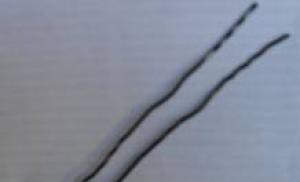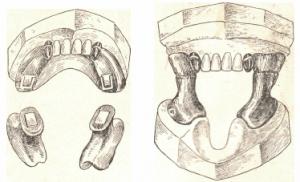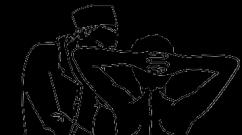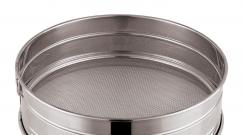How to count the phases of the moon. Lunar calendar online
> > What are the phases of the moon
Moon phases- change in the level of illumination of the Earth's satellite. Description of the new moon, waxing and waning moon, full moon with photos of solar and lunar eclipses.
From Earth, you can watch the moon go through a series of phases. Of course, it's all about the fall of the sun's rays. The satellite revolves around the Earth, which revolves around the Sun. We see only part of the moon, but one half of it is always illuminated. Spends 27.3 days on the orbital path.
In the course of the lunar phases, we encounter the Growing Moon - it is gaining illumination and the Waning Moon - the brightness is falling. Let's take a closer look at the phases of the moon.
- - the illuminated side is located away from us. The satellite and the star line up along one side, so we see the hidden half. At this moment, you can observe a solar eclipse if the Moon passes in front of a star and casts a shadow on the earth's surface.
- Crescent is the first observed arc. For the northern hemisphere, the light edge will be located on the right.
- The first quarter is half lit. That is, the satellite and the star form a 90-degree angle with respect to us.
- - more than half covered, but not yet complete.
- - maximum brightness. We see that the satellite is fully illuminated and can guarantee lunar eclipses.
- - a little more than half is lit, but the radiance is falling.
- Last quarter- half is illuminated, but already the opposite side.
- Crescent- the end of the lunar cycle.
If you live in the southern hemisphere, then the satellite begins to be illuminated on the left. Interestingly, the alignment of the Sun, Earth and Moon leads to amazing phenomena.

If we are faced with a full moon passing through the earth's shadow, then this is a lunar eclipse. The satellite is darker and filled with a bloody glow. If this is a new moon between a planet and a star, then we have a solar eclipse.

It seems that we should observe these amazing phenomena every month, but this is not so. The lunar orbit is inclined relative to the sun, so most of the time the satellite is located above or below the star. In the lower photo you can study the phases of Venus.

Surprisingly, Venus also goes through phases. If the planet is located on the other side of the star, then we observe an almost full disk. If it is on our side, then a thin crescent is shown. On our site you can always find out the phases of the moon today or use a special lunar calendar, where the phases of the satellite are scheduled for the whole year.
The moon that we can observe in the sky is fickle. It either shines with a full round disk, then begins to decrease, becoming a crescent, and then completely disappears from the sky, reappears, now in the form of a growing crescent ... It is these well-known changes in the visible appearance of the Moon that are called the change of lunar phases.
Moon phases
 The moon shines for us only due to the reflection of the sun's rays, and the change in the shape of the moon is an apparent phenomenon. In fact, the Moon, of course, always has a round shape - only the location of light and darkness on the hemisphere of the Moon facing us changes.
The moon shines for us only due to the reflection of the sun's rays, and the change in the shape of the moon is an apparent phenomenon. In fact, the Moon, of course, always has a round shape - only the location of light and darkness on the hemisphere of the Moon facing us changes.
The phases of the moon are different forms of the part of the moon that is visible from the Earth, illuminated by the Sun. If they determine our behavior, then the phases of the moon affect the state of our body, the degree of its vitality and activity.
Lunar phases are related to the position of the Moon relative to the Sun. Moon and Sun, a. The period from the new moon to the full moon is called, and from the full moon to the new moon -.
To describe the lunar month, the four phases of the moon are of practical importance:
1 Moon Phase - New Moon
The state when the moon is not visible.
This is the transition point from the Waning Moon to the Waxing Moon. The energy is practically non-existent, but the potential is huge. This is the beginning - I can't do anything, but there are great abilities to learn.
Moon Phase 2 - Waxing Moon
Fills the world with energy and astral information. This time is favorable for all kinds of undertakings and renewal.
3 Moon Phase - Full Moon
The state when the moon is fully lit
This is the transition point from the Waxing Moon to the Waning Moon. Energy is in full swing, the potential is fully realized.
4 Moon Phase - Waning Moon
Signifies a waste of energy. At this time, it is better to finish things or calmly continue them in accordance with your plans.
The new moon and full moon are the two main critical points of the lunar cycle. According to statistics, these days of the lunar month are the time of accidents and exacerbation of diseases. At this time, internal processes in the human body and psyche are unstable. Any undertaking these days is experiencing a temporary crisis. Folk wisdom warns against making important decisions on critical lunar days.
Phases of the moon for haircuts
The phases of the moon for cutting hair are an especially important moment in a woman's life. Sometimes the haircut turns out to be extremely successful, and sometimes not so much. Knowing the phases of the moon for hair cutting will help you always look attractive and have healthy strong hair.
Haircuts are best done on the full moon,. On a full moon, energy literally spills out of us over the edge. This is the day of activation and release to the surface of all the negative that the body has managed to accumulate. At this moment, all the heavy negative energy is on the surface of the body, including the ends of the hair. When we cut off these tips on the full moon, we remove the extra load, unnecessary information. Hair revives, rejuvenates, becomes thicker, falls out less. On the full moon, you can visit the hairdresser for any purpose: for styling, coloring, perm. It is also good to get a haircut with the growing moon, especially in or, besides, the hair grows faster. Cutting hair on the waning moon leads to their slow growth and disease. It is not recommended to cut your hair in and at any phase.
Removing excess hair from the body
Removal of excess hair should be done only on the waning moon, especially good at. In this case, the days of Leo and Virgo should be avoided.
Hair coloring
The paint applied with the growing moon lasts longer, the color is more intense. The paint applied during the waning moon is washed off faster.
What phase is the moon
The phases of the moon are the meanings of the four phases of the lunar cycle, thanks to which you can tune in to the lunar rhythms and begin to relate your life to them. By adopting this knowledge, you will begin to notice the influence of the phase of the lunar cycle on your mood and feelings. If desired, you can also mark each lunar phase with a specific ritual corresponding to its nature of action.
Start a lunar diary in which you will note all the changes in your mood and behavior in connection with the phases of the moon.
For example, in certain periods you have a lot of energy: on some days you are especially emotional, and on others you are creative; sometimes you eat or sleep more than usual, and sexual desire increases or, conversely, decreases. Why not start a separate diary for dreams?
In addition, it is useful to build at home in a secluded corner something like a small lunar altar, where there will be objects that remind you of the moon and its phases, such as candles, jewelry, cards, crystals, and whatever you like.
Depending on the position of the Moon relative to the Sun and the Earth, four different phases of our satellite can be observed from our planet.
1 New Moon
 2 First quarter - Waxing Moon
2 First quarter - Waxing Moon
 3 Full Moon
3 Full Moon
 4 Last Quarter - Waning Moon
4 Last Quarter - Waning Moon
General characteristics of the lunar phases


New moon
This is the state when the moon is not visible (Figure 1)
First quarter - Waxing Moon
This is the state when half of the moon is illuminated (Figure 3)
Full moon
- this is the state when the entire moon is illuminated (Figure 5)
Last Quarter - Waning Moon
This is the state when half of the moon is again illuminated (Figure 7)
To distinguish the first quarter from the last, you can use the rule we have already described. If the month looks like the letter "C", then it is "Aging", that is, this is the last quarter. If he moved in the opposite direction and then, mentally putting a wand to it, you can get the letter “P”, then the month is “Growing”, that is, this is the first quarter.
A growing month is usually observed in the evening, and an aging month is usually observed in the morning.
Seven factors influencing the phase of the moon
For many millennia, man lived in deep harmony with the diverse rhythms of nature in order to ensure his survival (lunar rhythms, rhythms associated with the activity of the Sun, with cosmic and terrestrial radiation, human biorhythms, etc.).
Regarding the lunar rhythms - phases of the moon, heightened senses, attentive and accurate observation of nature, the world of animals and plants to be discovered
Our ancestors used the phases of the moon in many ways:
- - a variety of natural phenomena: ebb and flow, births, weather whims, menstrual cycles in women and much more - are interconnected with the rhythms of the moon;
- - many animals in their actions are guided by the position of the phase of the moon, for example, birds collect material for nests at a certain time, so that the nests dry out very quickly after rain;
- - the success of endless daily activities: arranging firewood, cooking, eating, cutting hair, gardening, fertilizing, washing, house cleaning, body care and much more - depends on the rhythms of the moon;
- - operations and medications taken on certain days are very effective, while on others they are useless or even harmful (often this does not depend on the quality of medicines and the skill of doctors);
- - Plants and their parts are day by day under the guise of various energies, the knowledge of which is decisive for successful planting, care and harvesting;
- - Healing herbs collected at the right time, containing incomparably more active beneficial substances than those collected at other times.
So, 7 different factors of the influence of the moon are known:
- 1) New Moon
- 2) Waxing Moon
- 3) Full moon
- 4) Waning Moon
- 5) Position of the Moon in the Zodiac
- 6) Rising Moon
- 7) Descending Moon.
New moon

 If it is - when viewed from the Earth - between the Earth and the Sun, then its side facing the Earth is completely immersed in darkness. During this period of time, the earthly observer does not see the Moon - the new moon dominates. In this short period, the influence of a special impulse on people, animals and plants dominates: for example, if someone goes hungry on this day or arranges a fasting day, then he prevents many diseases, because
If it is - when viewed from the Earth - between the Earth and the Sun, then its side facing the Earth is completely immersed in darkness. During this period of time, the earthly observer does not see the Moon - the new moon dominates. In this short period, the influence of a special impulse on people, animals and plants dominates: for example, if someone goes hungry on this day or arranges a fasting day, then he prevents many diseases, because
That the readiness of the body for cleansing (liberation from toxins) is the greatest on this day. If a person wants to get rid of bad habits, then these days are more suitable for such an undertaking than any other.
Waxing Crescent
 Already a few hours after the new moon, the earthly observer begins to see the side of the moon facing the Earth. A thin sickle appears - the growing Moon - with its own specific event. The period of time after which half of the surface of the Moon illuminated by the Sun will be visible is called the first phase, and the period of time after which the entire surface will be visible is called the second phase.
Already a few hours after the new moon, the earthly observer begins to see the side of the moon facing the Earth. A thin sickle appears - the growing Moon - with its own specific event. The period of time after which half of the surface of the Moon illuminated by the Sun will be visible is called the first phase, and the period of time after which the entire surface will be visible is called the second phase.
Everything that has to be “introduced” into the body, that builds and strengthens it, has a double effect during phases I and II. The more the Moon grows, the more unfavorable operations and healing of injuries can proceed. And one more thing: for example, linen with the same amount of detergent will not be as clean after washing as when the moon is waning. With the growing moon and the full moon, more children are born.
Full moon

 Finally, the Moon has completed half of its journey around the Earth. The sun is the full moon. When viewed from the Sun, the Moon is now "behind" the Earth.
Finally, the Moon has completed half of its journey around the Earth. The sun is the full moon. When viewed from the Sun, the Moon is now "behind" the Earth.
For a few hours on the full moon, clearly felt forces become especially noticeable on the health of people, animals and plants, and the change in the direction of lunar impulses from decreasing to growing sensations is stronger than when the forces change at the new moon. "Sleepwalkers" wander in their sleep, wounds bleed more than at other times; Healing herbs collected on this day; greatest strength; Trees cut at this point may die; Police departments are reinforcing their posts, tk. They are aware of the increase in violence and accidents; Midwives work overtime.
Waning moon

 The Moon moves slowly (III and IV phases) until the new moon comes again.
The Moon moves slowly (III and IV phases) until the new moon comes again.
Again, we must be grateful to our ancestors for being able to appreciate the special influence of the moon at this time: operations are better than at other times; Almost all household chores are contested; If someone eats more
Than at other times, it does not add so quickly in weight. This period is favorable for planting "underground" vegetables and unfavorable for budding fruit trees.
Position of the Moon in the Zodiac

 When the Earth revolves around the Sun, the Sun, as viewed from the Earth, is in the same zodiac sign for about one month. The Moon also passes through the same signs of the Zodiac during its rotation around the Earth, and it lingers in each sign for approximately two and a half days.
When the Earth revolves around the Sun, the Sun, as viewed from the Earth, is in the same zodiac sign for about one month. The Moon also passes through the same signs of the Zodiac during its rotation around the Earth, and it lingers in each sign for approximately two and a half days.
Ancestors versed in healing discovered the following principles:
1) Everything that is done for the benefit of that area of the body that is governed by the sign that the Moon is just passing through, works much better at this time than on different days. With the exception of surgical interventions, which are unacceptable for that part of the body that controls the sign that the Moon is just passing through.
2) Anything that wears out that area of the body that is ruled by the sign that the Moon is just passing through, acts more strongly at this time than on other days.
3) Surgical operations on organs or parts of the body should be avoided at this time, if possible. Urgent operations are subject to another, higher law.
4) With the growing Moon, when it passes the corresponding sign, all measures for the introduction of reducing substances for participation in organizations are more successful than with the waning Moon. All measures for cleaning and unloading are more effective with a waning moon than with a growing one.
Libra, Sagittarius - Descending Moon Signs Gemini and Sagittarius are key points.
Both "ascending" and "descending" factors become noticeable as the Moon passes through the Zodiac - almost as if the forces of spring, summer, autumn and winter were felt for a single month.
The time of the rising moon is also called "harvest time", and the time of the descending moon is "planting time", because in agriculture and horticulture, participants are subject to other changes. With the rising Moon (from Sagittarius to Gemini), juices rise, fruits and vegetables are especially juicy, everything favors the development of the aerial parts of plants. With the descending Moon (Gemini to Sagittarius), the juices descend and promote the development of the roots.
Each lunar phase lasts 7.4 Earth days, and the countdown of the lunar phases begins with the new moon and corresponds to the lunar phases of the four natural elements - fire, earth, air or water.
If the nature of the lunar day to a very large extent determines our behavior, then the state of the body, the degree of its vitality and activity depend on the phase of the moon. And the sign of the zodiac determines our general emotional mood and inclination to a particular type of activity. So, let's describe all four lunar phases: new moon, waxing moon, full moon and waning moon.
First phase of the moon. New moon.
The element of the first phase is the earth, it is associated with the name of the goddess Artemis.
The moon during the new moon period is usually not visible, but with a very clear atmosphere, sometimes you can still see a dimly lit disk, "ash light" (this is reflected sunlight coming from the Earth).
During the new moon, you can sometimes see a solar eclipse.
The days of the new moon are also called the dark days or days of Hekate, which last two days before the new moon and two after the new moon. In the days of Hekate, many people have a noticeable deviation of both a mental and physical nature, strictly corresponding to the properties of the nature of the sign of the Zodiac and the main principles of the heavenly house of the horoscope, where the New Moon occurs.
During the period of the new moon, a person is most weakened, exhausted, the energy resources of the body are at a minimum. As the moon grows, our energy will also grow and accumulate until the full moon.
During the period of the new moon, it is not recommended to engage in heavy physical labor, it is better to minimize the load. It is necessary to try to minimize nervous tension and aggression, because it is during the period of the new moon that the greatest number of strokes and heart attacks is observed.
Also at this time, you should not start new business, conclude agreements or contracts. At this time, it is better to plan, collect and process information.
The new moon period is very favorable for getting rid of bad habits, for cleansing procedures, in order to go on a diet.
With the end of the days of Hekate, a small crescent of the Moon appears in the sky, a young growing moon. During the period of a young growing moon, our body is tuned to consume energy, to receive it from the outside, it saves strength and almost does not spend it. Physical activity can be increased gradually by 5,6,7 lunar days.
Second phase of the moon. Waxing Crescent
The element of the second phase is water and it is associated with the name of Thetis, the eldest daughter of the sea king Nereus and the moon goddess Selena.
At this time, the energy of the body increases, we become stronger, more active and emotional. There is already enough strength for new achievements, and fatigue is not yet felt. At this time, it is recommended to start new business, a person at this time is capable of much. Also, the second phase of the moon is very favorable for replenishing our body with nutrients and vitamins, that is, it is at this time on the growing moon that we more easily perceive everything that nourishes our body and supplies us with the necessary substances.
This period is reminiscent of mature youth, when there is still a lot of strength and plans ahead.
But the closer we get to the full moon, the more the excess of strength and energy in the body turns into excitement and excitement.
The full moon is the time for the transition from the accumulation of forces to their active expenditure. It is recommended to control your emotions on the full moon, since these days are already characterized by increased emotional tension and mood swings, especially these days greatly affect women. Many at this time have insomnia, exacerbate nervous breakdowns, quarrels arise "from scratch". Therefore, it is recommended to postpone all matters that require nervous overexertion for the period of the full moon. And those who have nowhere to put their excess energy, let them go in for sports, it will do you good good, you can also direct this energy into a love channel.
Full moon days are very good for collecting medicinal plants, as well as for therapeutic fasting. These days are unfavorable for performing surgical operations and going to the dentist.
Third phase of the moon. Full moon.
The element of the third phase is fire and it is associated with the name of the goddess Diana.
The time of the third phase of the moon is the period of maturity and activity of the organism that has accumulated energy. At this time, it is recommended that you continue to control your emotions and behave with the knowledge that the full moon is still in effect.
This is the time of active energy consumption, it is easier and more effective to go on diets at this time, this is a great time for deep skin cleansing and removal of toxins from it, fighting cellulite, and massage sessions.
The third phase of the moon is compared with the onset of full maturity, when a person is fully capable of doing everything that he is capable of. All things are easy and simple, but fatigue is not yet felt. This time should not be missed, because then, with the onset of the fourth phase of the moon, the body's strength will begin to wane.
Fourth phase of the moon. Waning moon
The element of the fourth phase is fire and it is associated with the name of the goddess Gorgon, although according to another version with the name of the moonfire goddess Eris.
This is the time of "old age" of the body. The flawed Moon is coming, and our energy also becomes flawed, sometimes everything falls out of hand, a person loses activity and starts to get tired. During this period, a decline in vital energy, biorhythms and immunity is characteristic. Therefore, during this period, only important things should be done, do not waste your energy. But with decreasing physical strength, we can receive new spiritual strength, we become wiser and begin to understand what we had not guessed before.
The fourth phase of the moon ends with difficult days - the days of Hecate. But four dark days will pass and we will again see a small lunar crescent in the sky. And everything will happen again.
Consistent change of the visible moon in the sky
The moon goes through the following phases of illumination:
- new moon- a state when the moon is not visible. New Moon is the phase of the Moon when its ecliptic longitude is the same as that of the Sun. Thus, at this time, the Moon is between the Earth and the Sun approximately on the same straight line with them. If they are exactly on the same straight line, a solar eclipse occurs. The moon at the new moon is not visible in the night sky, since at that time it is very close to the Sun in the celestial sphere (no further than 5 °) and at the same time turned to us by the night side. But sometimes it can be seen against the background of the solar disk (solar eclipse). In addition, some time later (usually about two days) after or before the new moon, with a very clear atmosphere, you can still see the disk of the Moon illuminated by weak light reflected from the Earth (ash light of the Moon). The interval between new moons averages 29.530589 days (synodic month). On the new moon, the Jewish New Year and the Chinese (Japanese, Korean, Vietnamese) New Year of the 60-year cycle begin.
- young moon- the first appearance of the moon in the sky after the new moon in the form of a narrow sickle.
- first quarter- a state when half of the moon is illuminated.
- waxing moon
- full moon- a state when the entire moon is illuminated as a whole. The full moon is the phase of the moon when the difference between the ecliptic longitudes of the sun and the moon is 180°. This means that the plane through the Sun, Earth and Moon is perpendicular to the plane of the ecliptic. If all three objects are on the same line, a lunar eclipse occurs. The moon in the full moon looks like a regular luminous disk. In astronomy, the moment of a full moon is calculated to within a few minutes; in everyday life, the full moon is usually called the period of several days, during which the moon visually almost does not differ from the full one. During a full moon, the so-called opposition effect can occur for several hours, in which the brightness of the disk increases noticeably, despite its unchanged size. The effect is explained by the complete disappearance (for a terrestrial observer) of the shadows on the surface of the Moon at the moment of opposition. The maximum brightness of the Moon during a full moon is -12.7m.
- waning moon
- last quarter- a state when half of the moon is again illuminated.
- old moon
To distinguish the first quarter from the last, an observer located in the northern hemisphere can use the following mnemonic rules. If the lunar crescent in the sky looks like the letter "C (d)", then this is the moon "Aging" or "Descending", that is, this is the last quarter (in French dernier). If it is turned in the opposite direction, then, mentally putting a wand to it, you can get the letter “P (p)” - the moon is “Growing”, that is, this is the first quarter (in French premier).
The growing month is usually observed in the evening, and the aging month is usually observed in the morning.
It should be noted that near the equator the moon is always seen "lying on its side", and this method is not suitable for determining the phase. In the Southern Hemisphere, the orientation of the crescent in the corresponding phases is opposite: the growing month (from new moon to full moon) looks like the letter "C" (Crescendo,<), а убывающий (от полнолуния до новолуния) похож на букву «Р» без палочки (Diminuendo, >). Interesting Facts Usually, there is one full moon for each calendar month, but since the phases of the moon change a little faster than 12 times a year, sometimes there is a second full moon in a month, called a blue moon.
YoIP Lunar Calendar is happy to tell you about today's lunar phase.
In total, eight periods of the moon's movement are distinguished, which it passes over a period from 29.25 to 29.83 Earth days. The generally accepted duration of a complete change of phases of the moon, a synodic month, is considered early 29 days 12 hours and 44 minutes.
The phases change in the following sequence: new moon (moon not visible), young moon, first quarter, waxing moon, full moon, waning moon, last quarter and old moon.
Scroll to ,
or information.
Today the Moon is in phase: Waxing Moon
4 lunar days are ending, the moon is visible at 16%
Moon in the zodiac sign Virgo ♍ and the constellation Virgo ♍
Detailed information about the phase of the moon today
| Household phase of the moon: | |
| Astronomical phase of the moon: | |
| Today the moon is in the sign of the zodiac: | ♍ Virgo |
| Today the moon is in the constellation: | ♍ Virgo |
| Today's lunar day: | 4 |
| The exact age of the moon: | 3 days, 19 hours and 34 minutes |
| Moon visibility: | 16% |
| Beginning of the current lunar cycle (new moon): | August 1, 2019 at 06:12 |
| The next new moon will be: | August 30, 2019 at 13:38 |
| The duration of this lunar cycle: | 29 days, 7 hours and 25 minutes |
| The exact time of the full moon of this cycle: | August 15, 2019 at 15:31 |
| The exact time of the next full moon: | September 14, 2019 at 07:35 |
| Further on the page: | |
| More to see: |
Moon phases in August 2019 by day.
The phases of the moon are shown for the noon of every day of August (12:00 Moscow time, UTC+3)
| Date | moon | Phase | Day | Zodiac | Constellation | Astronomical phase and visibility |
|---|---|---|---|---|---|---|
| August 1 | 1 | ♌ Leo | ♋ Cancer | Waxing moon in the first quarter The disk of the moon is not visible |
||
| August 2 | 2 | ♌ Leo | ♌ Leo | Waxing moon in the first quarter 2% of the moon's disk is visible |
||
| August 3rd | 3 | ♍ Virgo | ♌ Leo | Waxing moon in the first quarter 8% of the moon's disk is visible |
||
| 4 August | 4 | ♍ Virgo | ♍ Virgo | Waxing moon in the first quarter 15% of the moon's disk is visible |
||
| 5th of August | 5 | ♎ Libra | ♍ Virgo | Waxing moon in the first quarter 25% of the moon's disk is visible |
||
| 6 August | 6 | ♎ Libra | ♍ Virgo | Waxing moon in the first quarter 35% of the moon's disk is visible |
||
| August 7 | 8 | ♏ Scorpio | ♎ Libra | Waxing moon in the first quarter 46% of the moon's disk is visible |
||
| 8 August | 9 | ♏ Scorpio | ♎ Libra | 57% of the moon's disk is visible |
||
| August 9 | 10 | ♐ Sagittarius | ♏ Scorpio | Waxing moon in the second quarter 67% of the moon's disk is visible |
||
| August 10 | 11 | ♐ Sagittarius | ⛎ Ophiuchus | Waxing moon in the second quarter 76% of the moon's disk is visible |
||
| 11th August | 11 | ♑ Capricorn | ♐ Sagittarius | Waxing moon in the second quarter 84% of the moon's disk is visible |
||
| 12th of August | 12 | ♑ Capricorn | ♐ Sagittarius | Waxing moon in the second quarter 91% of the moon's disk is visible |
||
| 13 August | 13 | ♑ Capricorn | ♐ Sagittarius | Waxing moon in the second quarter 96% of the moon's disk is visible |
||
| 14 August | 14 | ♒ Aquarius | ♑ Capricorn | Waxing moon in the second quarter You can see 99% of the moon's disk |
||
| August 15 | 15 | ♒ Aquarius | ♑ Capricorn | Waxing moon in the second quarter 100% of the moon's disk is visible |
||
| 16 August | 16 | ♓ Pisces | ♒ Aquarius | You can see 99% of the moon's disk |
||
| 17 August | 17 | ♓ Pisces | ♒ Aquarius | Waning moon in the third quarter 97% of the moon's disk is visible |
||
| 18 August | 18 | ♓ Pisces | ♓ Pisces | Waning moon in the third quarter 93% of the moon's disk is visible |
||
| August 19 | 19 | ♈ Aries | ♓ Pisces | Waning moon in the third quarter 87% of the moon's disk is visible |
||
| 20 August | 20 | ♈ Aries | ♓ Pisces | Waning moon in the third quarter 80% of the moon's disk is visible |
||
| 21 August | 21 | ♉ Taurus | ♈ Aries | Waning moon in the third quarter 72% of the moon's disk is visible |
||
| 22 August | 21 | ♉ Taurus | ♈ Aries | Waning moon in the third quarter 63% of the moon's disk is visible |
||
| August 23 | 22 | ♉ Taurus | ♉ Taurus | Waning moon in the third quarter 53% of the moon's disk is visible |
||
| 24 August | 23 | ♊ Gemini | ♉ Taurus | 42% of the moon's disk is visible |
||
| 25-th of August | 24 | ♊ Gemini | ♉ Taurus | Waning moon in fourth quarter 32% of the moon's disk is visible |
||
| August, 26th | 25 | ♋ Cancer | ♊ Gemini | Waning moon in fourth quarter 22% of the moon's disk is visible |
||
| 27 August | 27 | ♋ Cancer | ♊ Gemini | Waning moon in fourth quarter 13% of the moon's disk is visible |
||
| August 28 | 28 | ♌ Leo | ♋ Cancer | Waning moon in fourth quarter 6% of the moon's disk is visible |
||
| 29 August | 29 | ♌ Leo | ♌ Leo | Waning moon in fourth quarter 2% of the moon's disk is visible |
||
| 30 August | 30 | ♍ Virgo | ♌ Leo | Waning moon in fourth quarter The disk of the moon is not visible |
||
| August 31 | 2 | ♍ Virgo | ♌ Leo | Waxing moon in the first quarter 1% of the moon's disk is visible |
What zodiac sign is the moon in today?
The moon is currently in the sign ♍ Virgo and the constellation ♍ Virgo.
Is the moon in a zodiac sign or a constellation?
Expression "Moon in the sign of the zodiac", for example, in the sign "Pisces", implies its astrological position within the boundaries of the zodiac sign. The zodiac sign is one twelfth of the ecliptic, which is 30°. Belongs to the tropical zodiac.
Expression "Moon in the constellation", for example, in the constellation "Aquarius", implies its astronomical position within the boundaries of the constellation. The boundaries of the constellations have different shapes, and the moon is in them for different times. Constellations belong to the astronomical zodiac.
This difference arose due to the precession of the earth's axis and the associated displacement of the vernal equinox for 2000 years by about one sign back. Therefore, you can often hear the following clarification: "The moon is in the sign of Pisces and the constellation of Aquarius." In addition, in the astronomical interpretation, the thirteenth constellation "Ophiuchus" is added to the twelve constellations consonant with the signs of the zodiac. You can read more about the dates of the intersection of the astronomical and astrological signs of the zodiac on the page.
What phase is the moon today?
Now the moon is in the phase "Waving moon in the first quarter"
What are the phases of the moon?
Distinguish household and astronomical phases of the moon. Their names are the same, and the difference is only in the duration of the phases of the new moon and full moon. In everyday life, they last for 2-3 Earth days each, until the moon is practically invisible (new moon) or visible almost like a full disk (full moon). But in an astronomical sense, the duration of these phases is less than a second.
The reason for this is that the moon moves around the earth at a speed of about 1023 m / s, and the full moon and new moon are the moments when the earth, moon and sun line up on the same plane perpendicular to the direction of the earth's movement around the sun. These moments are very fleeting and if you try to calculate their duration with an accuracy of coincidence of the positions of the moon, earth and sun at least up to one meter, then the duration will be less than 1/1023 of a second.
In our calendar, the duration of astronomical phases is calculated with an accuracy of one moon diameter (about 3476 km), which gives approximately 56.5 minutes.
The duration of everyday phases is considered based on the visibility of the moon's disk less than 3.12% for the new moon and more than 96.88% for the full moon.
Which moon is waxing or waning now?
How do you know if the moon is waxing or waning today?
You can understand what moon is in the sky now according to the mnemonic rule for the northern hemisphere: if the moon looks like the letter “ FROM", that is FROM waning or waning moon. If, when adding a vertical stick to the month, the moon becomes like the letter " R", then she R growing.
For the southern hemisphere, the opposite is true. There, the moon is seen upside down, so musical terms are used to memorize C rescendo (or sign "<„) для растущей луны и D iminuendo (">" sign) for descending.
At the equator, the moon lies on its side, so both of these options will not be applicable. Instead, they are guided by the time when the “boat” of the moon is visible. If in the evening and in the west, then this is the growing moon follows the sun, and if in the morning and in the east, then this is the aging moon. The lunar arch at the equator cannot be seen with the ordinary eye, because. it will always fall in the daytime and the bright light of the sun will make it difficult to see it.
What is the lunar day today?
Now the 4th lunar day is coming to an end. 19 hours and 34 minutes have passed since the beginning.
Lunar days and lunar days. What is the difference?
Lunar day- this is the period of time that passes from the moment of the new moon to the re-crossing of the meridian line by the moon, over which the moon was at the time of the new moon. The first lunar day begins its countdown at the moment when the center of the moon crosses the line connecting the earth and the sun (the moment of the new moon). The second and subsequent days begin when the center of the moon crosses the meridian over which the moment of the new moon occurred in this lunar cycle.
The average length of a lunar day is about 24 Earth hours, 50 minutes and 28 seconds. This happens because the earth and the moon rotate in the same direction and while the earth makes a complete revolution, the moon has time to run away from it a little forward and the earth has to turn a little more so that the moon is exactly above the meridian as one lunar day ago .
Lunar days are considered from sunrise to sunset of the moon at each specific point on the globe. At the same time, the beginning of the first lunar day occurs as the beginning of the first lunar day at the time of the new moon, and the second and subsequent lunar days are counted from moonrise. The duration of lunar days and their number in each point of the globe is different. The usual number of lunar days is from 29 to 30 per lunar cycle. However, in some places where the moon may not rise or set for several Earth days, the number of lunar days may be much less. This affects the territories beyond the northern and southern polar circles. There for half a year you can not see either the sun or the moon.













